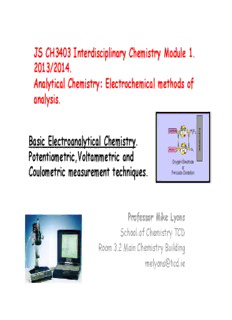
Analytical Chemistry - School of Chemistry PDF
Preview Analytical Chemistry - School of Chemistry
JS CH3403 Interdisciplinary Chemistry Module 1. 2013/2014. Analytical Chemistry: Electrochemical methods of analysis. Basic Electroanalytical Chemistry. Potentiometric,Voltammetric and Coulometric measurement techniques. Professor Mike Lyons School of Chemistry TCD Room 3.2 Main Chemistry Building [email protected] Electro-analytical Chemistry. Electroanalytical techniques are concerned with the interplay between electricity & chemistry, namely the Electro-analytical chemists at work ! measurement of electrical quantities Beer sampling. such as current, potential or charge Sao Paulo Brazil 2004. and their relationship to chemical parameters such as concentration. The use of electrical measurements for analytical purposes has found large range of applications including environmental monitoring, industrial quality control & biomedical analysis. EU-LA Project MEDIS : Materials Engineering For the design of Intelligent Sensors. Outline of Lectures • Introduction to electroanalytical chemistry: basic ideas • Potentiometric methods of analysis • Amperometric methods of analysis • Coulombic methods of analysis J. Wang, Analytical Electrochemistry, 3rd edition. Wiley, 2006 R.G. Compton, C.E. Banks, Understanding Voltammetry, 2nd edition, Imperial College Press,2011. C.M.A. Brett, A.M.Oliveira Brett, Electrochemistry: Principles, methods and applications, Oxford Science Publications, 2000. Why Electroanalytical Chemistry ? Electroanalytical methods have certain advantages over other analytical methods. Electrochemical analysis allows for the determination of different oxidation states of an element in a solution, not just the total concentration of the element. Electroanalytical techniques are capable of producing exceptionally low detection limits and an abundance of characterization information including chemical kinetics information. The other important advantage of this method is its low cost. Electroanalytical methods. • Electrochemical reactions involve electron transfer (ET) processes at electrode solution interfaces. These ET reactions may be kinetically sluggish or kinetically facile depending on the details of the ET reaction and the nature of the electrode surface. • Provided an analyte species exhibits electroactivity (can be oxidised or reduced) then it may be detected using the tools of electrochemistry. • Thus, electrochemical methods may be split up into two major classes : Potentiometric and Amperometric. • In potentiometry the ET reaction is kinetically facile and we measure the potential of a Galvanic cell under conditions of zero current flow. The cell potential responds to changes in the activity of the analyte species present in the solution in a well defined manner described by the Nernst equation. Indeed the cell potential varies in a linear manner with the logarithm of the analyte activity. • In amperometry the kinetics of the ET reaction will have to be driven by an applied potential and so we measure the diffusion controlled current flowing across the electrode/solution interface. This current is directly proportional to the bulk concentration of the analyte present in the solution.
Description: